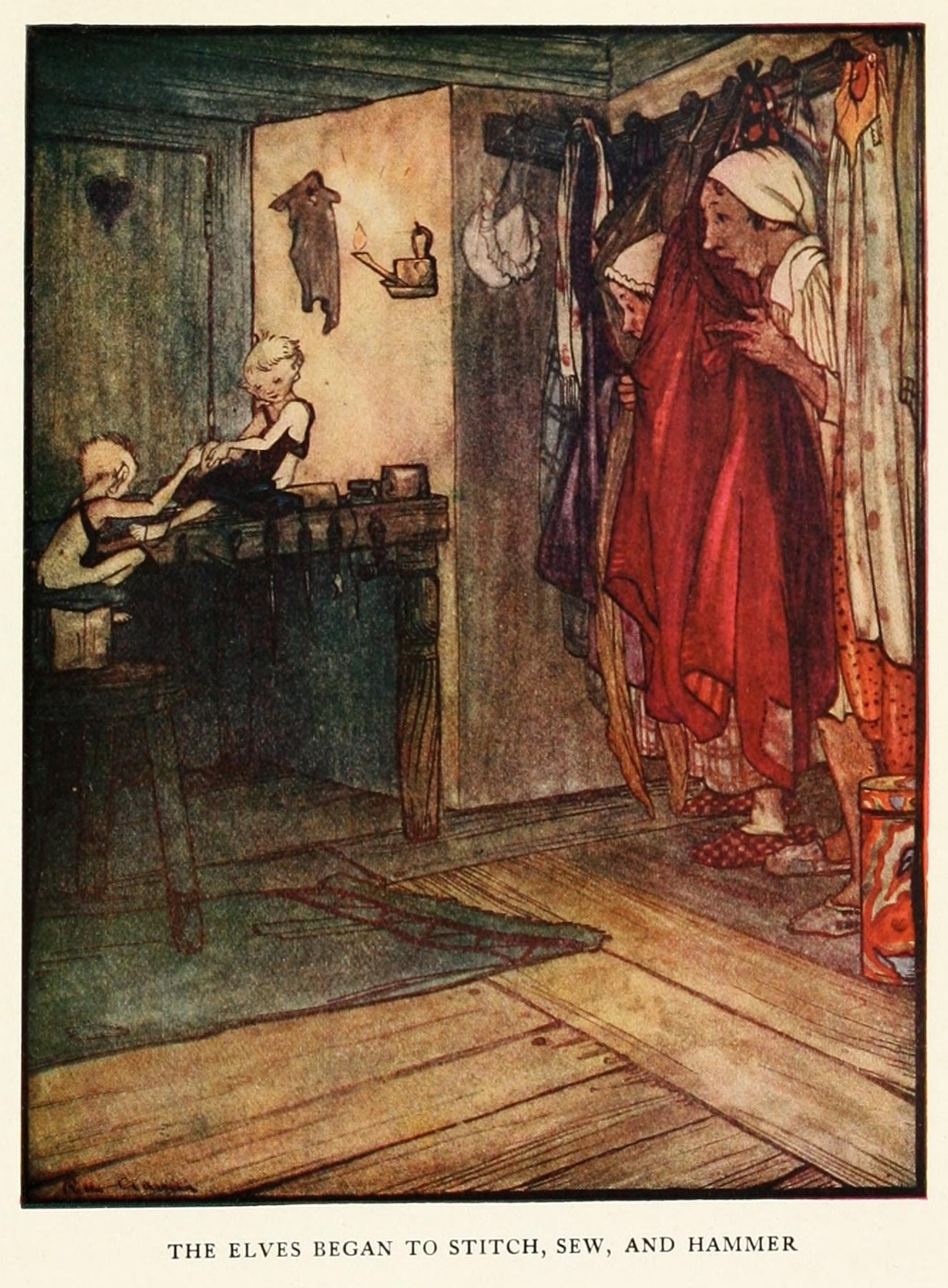For those who need a refresher, Schonwerth collected tales from Bavaria around the same time as the brothers Grimm, but the stories in this book are actually from people native to the region, and remained unaltered throughout the years, unlike the popular Grimm's tales. From my archives, you can read about the mermaid tales and witch tales in the collection.
Arthur Rackham
When we think of fairy tale dwarves, we are sure to remember "Snow White and the Seven Dwarfs", and some people may be familiar with "Snow White and Rose Red". From these two tales we see the dual nature of dwarfs in folklore; they can be helpful and kind, as they were to Snow White, yet rude and ungrateful in the latter story.
Rie Cramer
Like the dwarves in "Lord of the Rings", dwarves often lived in mountains, creating a system of tunnels, and were known for their work with precious metals. In one story they made a necklace that would make anyone who saw it love the wearer-this was for a wife who was afraid she would lose her husband's love. Yet in payment for this treasure, she had to give herself to the Dwarves. When the woman's husband found out what she had done, he left her-ironically bringing about the fate the wife had tried to avoid. The husband did eventually reconcile himself to his wife, but it's a reminder that powerful magic often comes at a price...
Brian Froud
Yet not all dwarves were as friendly-one castle was known as haunted; the dwarves there would scatter the sheep at night, causing them to fall off the mountain, so the castle was avoided.
John Batten
Two stories in particular reminded me of traditional fairy tales. "Beautiful Bertha, the Red Shoe, and the Golden Needle" is essentially a Cinderella tale. A beautiful nobleman's daughter, Bertha, and a shepherd's daughter, Hylde, were switched at birth. Bertha became a maid for Hylde, and being jealous of Bertha's beauty, Hylde gave her the hardest chores, and humiliated her as often as possible. A prince came through looking for a bride, but passed by their castle. But Dwarves came, bringing with them a red shoe and golden needle, saying that the one who owned both things would be the prince's bride. When the shepherdess, Hylde's true mother, revealed the truth, Hylde threw herself from the tower, and Bertha became the prince's wife. So in this story we have the elements of persecuted heroine, aid from magical helpers, and recognition by a shoe. (I had recently done a post on red shoes in fairy tales, so we can add this to the list of significant red shoes!)
Anne Anderson
"Tale of the Forest Dwarf" is very similar to Rumpelstiltskin, yet the dwarf in this version seems kinder overall. A very poor man with many children to feed came across a dwarf clad in green, who led him to a cave of treasures. The treasure could all belong to the poor man, if he could guess the dwarf's name in three days. The dwarf was under a spell and had to guard the treasures until someone could guess his name and say it out loud. The man went home and told his wife.
She prayed and went to find the dwarf herself. She overheard him lamenting about how easy it would be for them to guess his name because of his little pointed beard. So she came in her husband's place and guessed, "Little Pointed Beard!", and the dwarf turned into a dove and flew away; the poor family was able to enjoy all the treasures.







Y'know, when it comes to the dwarves in Snow White, I never considered the idea that they might be magical types. I always figured they were dwarves in the sense of being people with dwarfism. However, most of the dwarves in these other stories seem to be magical creatures.
ReplyDeleteMost people are probably so used to the cutesy, Disney dwarves that they also don't realize what associations people would have had with Dwarves in the past. Christie of "Spinning Straw into Gold" has a great post called "The Domestication of Dwarves" that discusses how the fearsome and magical aspects of many fairy tale creatures have been lost in current movies: http://spinstrawintogold.blogspot.com/2012/06/domestication-of-dwarfs.html
DeleteWell, which kind of dwarf it is can change the perception of the story completely. Now, in the case of Snow White, I figured they were dwarves in the sense of being little people (note: there are two kinds of little people in the world: midgets and dwarves. And there are probably more technical politically correct terms for both). I thought this because it seemed like it would make sense. With a villainess who is both gorgeous and really hung up on traditional physical beauty, it made sense that the heroes (and yes, I see the dwarves as the heroes) would be kind of . . . different-looking. Heck, maybe even outcasts because of their appearance. However, if they're dwarves in the Norse mythological/Tolkien sense, then it's a whole different ballgame.
DeleteThat's a good point, I hadn't really thought before about how the dwarves are a physical contrast to the Queen and her beauty ideals. Although, whether or not they are physically shorter than average, or mythical dwarves, they would still not fit into the standards for "ideal" manly beauty, and I think the irony works for either kind of dwarf.
DeleteGood to see so many aspects of dwarves. I like Adam's point about their being dwarves and midgets - really would change the perspective of the story, plus fairy tales tend to generalise and make anyone small called a dwarf regardless of whether they're magical or not.
ReplyDeleteI like how the dwarf in 'Tale of the Forest Dwarf' is cursed, as opposed to nasty like Rumpelstiltskin. It makes a happy ending for everyone - he gets freed, and the family get the treasure. Interesting how this tale has no villains present, apart from perhaps who cursed the dwarf but this isn't mentioned. Also, what did the dwarf do to become cursed, and why is his curse to guard the treasure? Lots for the writer in me to contemplate!
It's funny, I think I had always assumed that fairy tale dwarves were the magical sort, but it would be interesting to do a survey and see who automatically thinks of them as being Little People instead.
DeleteYou're right, "Tale of the Forest Dwarf" is more pleasant all around because you end up rooting for everyone. And like in Beauty and the Beast, most versions don't explain the curse, the audience usually just accepts its existence and it becomes the villainous force of the story. But it would be fun to hear what you come up with! Or, what if Rumplestiltskin had once had the same curse, but over time became more bitter and manipulative when he seemed doomed to remain cursed?
I really enjoyed reading this blog. These are very interesting takes on dwarves. Anyway, what were the stories about Little Rose, the woman who had to sleep with dwaves, the one with Eve, and the one with the haunted castle are from? I would love to read those for myself. :)
ReplyDelete